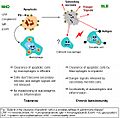Lupus facts for kids
Lupus, or Lupus erythematosus, is a disease of the immune system. It is chronic, which means it does not go away. It is an autoimmune disease, where the person's immune system attacks their own body.
The immune system is partly made up of white blood cells in your body that fight off disease. In lupus, these white blood cells think that the healthy cells of the body around them are diseased, so they end up attacking healthy parts of the body. Lupus can be deadly. It causes swelling and tissue damage, and can attack any part of the body. It most commonly affects the heart, joints, skin, lungs, blood vessels, kidneys and the brain/nervous system. Some symptoms include: fatigue, fever with no cause, hair loss, mouth sores, sensitivity to sunlight, a skin disease, and Raynaud's syndrome. There is treatment for lupus, called immunosuppression, which is medicine that stops the white blood cells from damaging healthy cells for a while. After a while, this medicine wears off, and then the white blood cells go back to hurting healthy parts of the body again. For the disease of lupus, there is no cure that stops the white blood cells from attacking healthy parts of the body forever, but doctors are not giving up on finding a cure.
Lupus takes its name from the Latin word "lupus", meaning wolf. This is because a lupus-caused rash on a person's face makes the person's face look like the face of a wolf. In the United States alone, there may be 270,000 to 1.5 million (1,500,000) people with lupus. Worldwide, it is estimated (not known for sure, but a good guess) that over 5 million (5,000,000) people living with lupus. The disease mainly affects young women, but men can be affected as well.
Famous people with lupus
- Disney Star Selena Gomez was diagnosed with lupus in 2013.
- The pop singer Michael Jackson was diagnosed with systemic lupus in 1986.
- Toni Braxton has systemic lupus.
- British singer-songwriter Seal has had scarring on his face due to lupus since the age of 23.
Images for kids
-
Germinal centres in a person with SLE and controls (schematic). Red: CD68 in tingible body macrophages; black: TUNEL positive apoptotic cells. 1) Healthy donors with florid germinal centres show giant tingible body macrophages (TBM) containing ingested apoptotic cells and no uningested apoptotic cells outside the TBM. 2) People with follicular lymphoma show small tingible body macrophages (TBM) containing few ingested apoptotic cells however, there are no uningested apoptotic cells outside the TBM. 3) Some with SLE (1) show a lack of TBM and many uningested apoptotic cells decorating the surfaces of spindle-shaped cells, presumably follicular dendritic cells (SLE 1). 4) Some people with SLE show TBM containing few ingested apoptotic cells and many uningested apoptotic cells outside the TBM (SLE 2). However, about 50 % of people with SLE show rather normal germinal centre.
-
Micrograph showing vacuolar interface dermatitis, as may be seen in SLE. H&E stain.
-
Micrograph of a section of human skin prepared for direct immunofluorescence using an anti-IgG antibody. The skin is from a person with systemic lupus erythematosus and shows IgG deposits at two different places. The first is a bandlike deposit along the epidermal basement membrane ("lupus band test" is positive); the second is within the nuclei of the epidermal cells (antinuclear antibodies are present).
See also
 In Spanish: Lupus eritematoso sistémico para niños
In Spanish: Lupus eritematoso sistémico para niños







